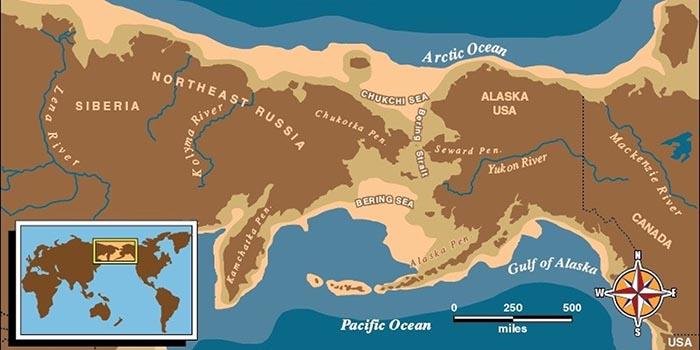By: Jesse Farmer, University of Massachusetts Boston and Tamara Pico, University of California Santa Cruz
Beringia, between the Lena River in Russia and the Mackenzie River in northern North America, has experienced profound changes in local sea level over the Quaternary Period that reshaped the Northern Hemisphere's continental and oceanic connections. Today, the Bering Strait connects the Pacific and Arctic Oceans. However, at the peak of the last ice age some 20,000 years ago, lowered global sea level cut off this ocean connection; in its place, Asia and North America were linked via the Bering Land Bridge. While the demise of the Land Bridge due to sea level rise had been dated to around 11,000 years ago, the time when this ice age Land Bridge first formed had been a mystery.

Now, an interdisciplinary team of Earth scientists has dated the formation of the Bering Land Bridge to 36,000 years ago, within 10,000 years of the last ice age peak. The study was published in Proceedings of the National Academy of Sciences. This new date greatly shortens the window of time during which Asia and North America were connected, with implications for understanding ice sheet and sea-level history, past terrestrial migrations, and the causes of cyclic ice ages.
To obtain these results, we needed to leverage breakthroughs across three areas of Earth sciences research. First, we needed an indicator for when the Bering Land Bridge was present. We approached this from an ocean perspective. It has long been known that the Bering Strait transports large quantities of ocean nutrients northward into the Arctic Ocean. In the last decade, extensive sampling of Arctic Ocean waters on international research expeditions found a fingerprint of Pacific influence on the nutrient nitrogen in the Arctic Ocean.
Watch: Collecting Arctic Ocean seawater on the US Coast Guard Cutter Healy during the 2015 US GEOTRACES cruise (PolarTREC/Bill Schmoker)
&t=97s
Nitrogen has two stable isotopes, the abundant nitrogen-14 and the rare nitrogen-15. Nitrogen flowing across the Bering Strait is uniquely tagged by higher amounts of nitrogen-15 relative to other sources of nitrogen in the Arctic Ocean. If this Pacific nitrogen supply was cut off by formation of the Land Bridge, we would expect to see a large decline in the nitrogen-15 excess in the Arctic Ocean.
Second, we needed a way to assess this Pacific nitrogen fingerprint back in time. This was achieved using sediment records collected from the Arctic Ocean seafloor during the revolutionary 1994 Arctic Ocean Section. The sediments recovered contained high numbers of fossil foraminifera, carbonate shells that are the remains of zooplankton (Figure 2). In addition to their carbonate (which was radiocarbon dated to tell the ages of samples), the shells also contain layers of organic matter that are the fossilized tissue of the living organism. This fossil organic matter contains abundant nitrogen, and its nitrogen-15 excess was measured over the last 50,000 years.

The results showed three distinct intervals: a time of high nitrogen-15 excess between 50,000 and 36,000 years ago; a rapid decline to low nitrogen-15 excess at 36,000 years ago, lasting until about 11,000 years ago; and a rapid return to high nitrogen-15 excess covering the last 11,000 years. These data confirm that the Bering Strait was flooded for the last 11,000 years, as was previously known, but show for the first time that the Bering Strait had been previously flooded before 36,000 years ago. As a result, our data were able to constrain that the Bering Land Bridge existed between 36,000 and 11,000 years ago.
Finally, given information on when Beringia possessed an ocean gateway or a Land Bridge, we needed to understand how changes in sea level at the Bering Strait relate to global sea level. During the ice age, massive continental ice sheets store Earth's water, lowering global sea level and exposing the Bering Strait as a Land Bridge. But, unlike a bathtub, sea level around the world does not change uniformly.
Instead, the growth and decay of ice sheets causes local sea level to change in distinctly different patterns all around the globe because of two major processes. First, in the process of isostatic adjustment, the weight of ice sheets is so heavy that it causes the Earth to deform under its weight, causing the crust to be pushed down under ice sheets, and lifted up around them, as though the Earth was acting as an elastic bread dough that has been punched down. The other process that changes sea level globally is due to the gravitational attraction between oceans and ice sheets. Ice sheets are so massive that they exert a gravitational pull on the surrounding oceans. When ice sheets melt, counterintuitively this causes local sea level to fall near the ice sheets as the gravitational pull dissipates. To predict sea level at the Bering Strait, we must model these deformational and gravitational processes known as glacial isostatic adjustment.
Taken together, the new nitrogen isotope data and glacial isostatic adjustment modeling not only define past intervals when the Bering Land Bridge existed, they also raise questions concerning Earth's climate and sea level history. It was long thought that sea level was quite low around 50,000 years ago, reflecting a slow and steady buildup of continental ice sheets leading up to the peak of the last ice age. This is known as the "sawtooth" pattern of glacial cycles, where ice growth happens slowly leading up to peak ice ages, but ice melts rapidly upon the end of the glaciations. Yet, our observations of a flooded Bering Strait between 50,000 and 36,000 years ago requires much higher sea level at this time than once thought. In turn, these observations raise questions concerning how and why sea level was so high during this interval prior to the ice age peak.
Going forward, our work continues on two fronts. First, with continued support from the National Science Foundation, we are extending these records back in time to the last interglacial, about 125,000 years before present. These records will be used to test whether the Bering Land Bridge was present during each of the three multi-millennial cold periods prior to 50,000 years ago (referred to as Marine Isotope Stages 4, 5b, and 5d). Second, we seek to combine these new insights on Beringian sea-level history with the research outputs of communities studying the terrestrial paleoclimate history of Alaska, regional sea level markers and ice sheet history, and past land and ocean migrations established via ancient DNA and other approaches. In combination, we hope that these new tools and scientific discoveries will refine past sea level in Beringia and lead to a better understanding of Beringia's critical role in Earth's environmental history.
For more information, see: Beringia - Bering Land Bridge National Preserve (US National Park Service).
About the Authors
 jesse.farmer [at] umb.edu (Jesse Farmer) is an Assistant Professor in the School for the Environment at the University of Massachusetts Boston. His research uses chemical measurements on ocean sediments to infer past changes in ocean currents, biological production, and greenhouse gas cycling. He is currently focused on reconstructing the conditions of the Arctic Ocean during past warm intervals to better understand how the Arctic will respond to continued climate warming.
jesse.farmer [at] umb.edu (Jesse Farmer) is an Assistant Professor in the School for the Environment at the University of Massachusetts Boston. His research uses chemical measurements on ocean sediments to infer past changes in ocean currents, biological production, and greenhouse gas cycling. He is currently focused on reconstructing the conditions of the Arctic Ocean during past warm intervals to better understand how the Arctic will respond to continued climate warming.
 tpico [at] ucsc.edu (Tamara Pico) is an Assistant Professor in Earth and Planetary Sciences at the University of California Santa Cruz. Her research uses the interactions between ice sheets and the solid Earth as a lens to understand the relations between ice sheets, sea level, and landscapes in the past. She uses glacial isostatic adjustment modeling to infer variations in past ice sheets and improve sea level reconstructions on glacial cycles.
tpico [at] ucsc.edu (Tamara Pico) is an Assistant Professor in Earth and Planetary Sciences at the University of California Santa Cruz. Her research uses the interactions between ice sheets and the solid Earth as a lens to understand the relations between ice sheets, sea level, and landscapes in the past. She uses glacial isostatic adjustment modeling to infer variations in past ice sheets and improve sea level reconstructions on glacial cycles.
